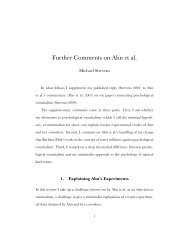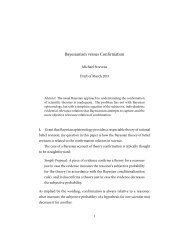The Essentialist Aspect of Naive Theories - Michael Strevens
The Essentialist Aspect of Naive Theories - Michael Strevens
The Essentialist Aspect of Naive Theories - Michael Strevens
Create successful ePaper yourself
Turn your PDF publications into a flip-book with our unique Google optimized e-Paper software.
1. To distinguish several different varieties <strong>of</strong> psychological essentialism,<br />
2. To argue that one <strong>of</strong> these is superior to the rest, and<br />
3. To argue that there is a non-essentialist hypothesis better supported<br />
by the data than any essentialist hypothesis. Rather than attributing<br />
beliefs about essences to children, the non-essentialist hypothesis attributes<br />
beliefs about causal laws. As a result, I will show, it better<br />
explains the experimental results that have previously been thought<br />
to support essentialism.<br />
What is the evidence for psychological essentialism? <strong>The</strong> hypothesis<br />
seems to be the best explanation <strong>of</strong> certain patterns <strong>of</strong> inference found in<br />
children and adults. <strong>The</strong> patterns in children include those described in<br />
S. Gelman and Markman (1986), Keil (1989), S. Gelman and Wellman<br />
(1991), and others cited below. <strong>The</strong> patterns in adults are described in Putnam<br />
(1970) and Rips (1989), among others. I will be most concerned with<br />
the patterns found in children’s thinking about natural kinds, with emphasis<br />
on the kinds <strong>of</strong> naive biology, the subject <strong>of</strong> most <strong>of</strong> the relevant research. 2<br />
Because these patterns <strong>of</strong> inference are associated with thinking about natural<br />
kinds, I will call them the K-patterns <strong>of</strong> inference. Most <strong>of</strong> this paper<br />
will be concerned with the ways in which different varieties <strong>of</strong> psychological<br />
essentialism explain, and sometimes fail to explain, the K-patterns.<br />
1. Varieties <strong>of</strong> Essentialism<br />
I will distinguish three varieties <strong>of</strong> essentialism that have been attributed to<br />
children, and I will add a fourth hypothesis <strong>of</strong> my own that is not essentialist<br />
at all.<br />
2. Relevant research on naive biology includes Atran (1990), Medin and Atran (1999),<br />
some <strong>of</strong> the studies just mentioned—S. Gelman and Markman (1986), Keil (1989), and Gelman<br />
and Wellman (1991)—as well as much other work cited below. Other naive theories<br />
that may be essentialist are our naive “chemistry” concerning kinds <strong>of</strong> substances (Gelman,<br />
1988; Keil, 1989) and some theory or theories that constitute part <strong>of</strong> our understanding<br />
<strong>of</strong> social relations (Rothbart & Taylor, 1994; Hirschfeld, 1996). It is unclear whether any<br />
further naive theories, such as those <strong>of</strong> physics and psychology, are essentialist (see Gelman<br />
and Hirschfeld (1999) for a discussion). At least one writer has suggested that all <strong>of</strong> our<br />
concepts—including, for example, the concept <strong>of</strong> a wastebasket—are founded in essentialist<br />
theories (Medin, 1989, 1477). But there is strong evidence that many <strong>of</strong> the characteristics<br />
<strong>of</strong> essentialist thinking are not to be found in our reasoning concerning artifacts such as<br />
wastebaskets (Keil, 1989).<br />
2






